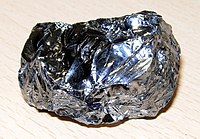
Photo from wikipedia
Covalently bonded ceramics exhibit preeminent properties—including hardness, strength, chemical inertness, and resistance against heat and corrosion—yet their wider application is challenging because of their room-temperature brittleness. In contrast to the… Click to show full abstract
Covalently bonded ceramics exhibit preeminent properties—including hardness, strength, chemical inertness, and resistance against heat and corrosion—yet their wider application is challenging because of their room-temperature brittleness. In contrast to the atoms in metals that can slide along slip planes to accommodate strains, the atoms in covalently bonded ceramics require bond breaking because of the strong and directional characteristics of covalent bonds. This eventually leads to catastrophic failure on loading. We present an approach for designing deformable covalently bonded silicon nitride (Si3N4) ceramics that feature a dual-phase structure with coherent interfaces. Successive bond switching is realized at the coherent interfaces, which facilitates a stress-induced phase transformation and, eventually, generates plastic deformability. Description Phasing out fracture Ceramics are not known for deforming in a plastic manner, instead tending to fracture as a response to loading. J. Zhang et al. found a method to avoid fracture and dramatically improve the ductility of silicon nitride (see the Perspective by Frankberg). The authors produced dual-phase silicon nitride samples that turned out to have coherent interfaces between the phases. This configuration allows for two sliding and two-phase transformation steps during loading that circumvent the traditional tendency of bonds to break and materials to fracture. If the mechanism works in other ceramics, then it may be a way to make them more plastic. —BG A coherent interface design makes brittle silicon nitride ceramics deformable mediated by a stress-induced phase transformation.
Journal Title: Science
Year Published: 2022
Link to full text (if available)
Share on Social Media: Sign Up to like & get
recommendations!